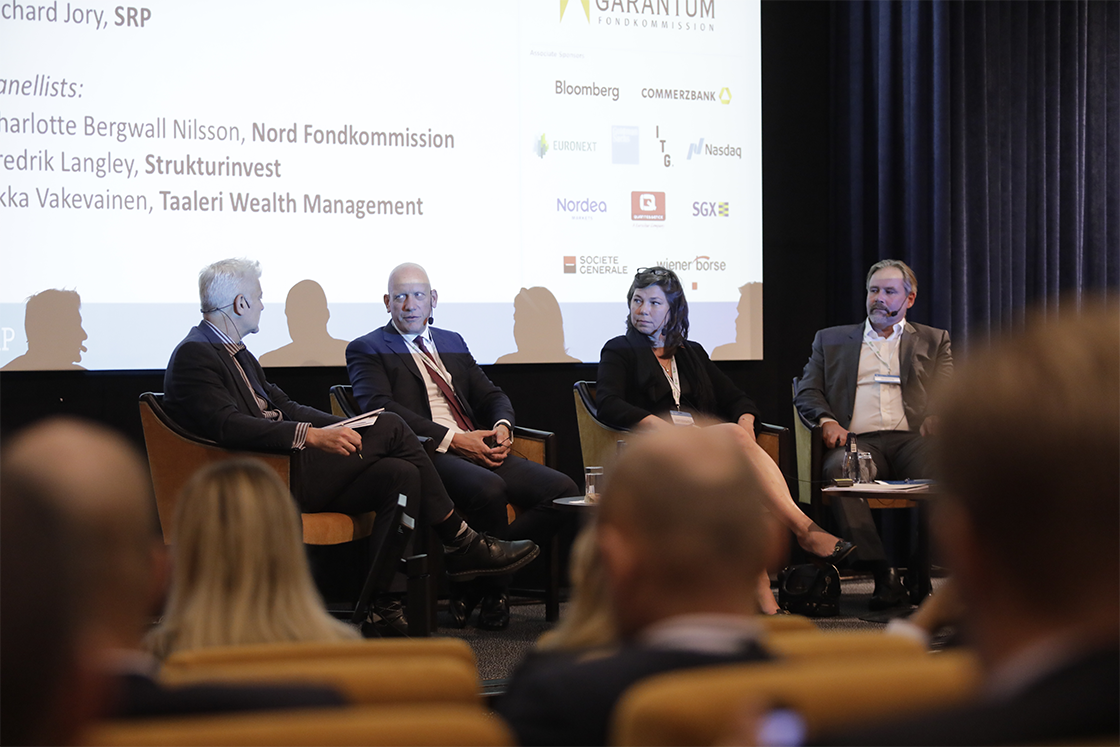Why should people buy structured products? Which product features are the most important? And is capital protection still a unique selling proposition? Those were among the topics of the Who is providing the return? The art of choosing the right product panel discussion, during SRP's fourth Nordic Structured Products & Derivatives Conference in Stockholm on September 13, 2018.
The most important thing about structured products is the risk adjusted return, according to Fredrik Langley (pictured), founding partner, Strukturinvest. "[Risk adjusted return] is the name of the game, at least for us," he said.
Charlotte Bergwell Nilsson (pictured below), chief executive officer, Nord Fondkommission, said there are a few important areas. "One is obviously to use volatility," she said. "If something has high volatility, or no volatility, then you have a possibility of producing something which is different. In essence, since we want to be able to produce dynamic returns, structured products themselves obviously have something different to offer compared to bonds or equity."

According to Ilkka Väkeväinen, director, structured debt and investment solutions, Taaleri, it is more of a twofold thing. "First of all there are the portfolio management type of benefits the products can provide, hence quite a big part of the structured products we do nowadays is credit because it is difficult to get fixed income returns from anywhere," he said. "Secondly, structured products are extremely tangible. Returns are pre-set, they are understandable, and theme driven and as such they work well for active investors too."
Capital protection is still a huge selling point, according to Langley. "There is correlation between interest rates and the volumes in structured products," he said. "The dream is hundred/hundred, i.e. 100% protected and 100% participation," said Langley, adding that once interest rates start to come up, a client segment which has not been around for a couple of years, municipality's, trusts etc. could probably re-enter the market. "People who are not in the business to take risks, for political reasons or personal reasons, for them this is quite a good product. You can gamble on the market but you will get your money back."
The issue, according to Bergwell Nilsson, is that some people don't have an understanding of structured products "and then obviously you have a problem". "You either want to make sure that you have a safe portfolio and a little bit of extra on the site which can provide a higher return, or, if they have a very large portfolio, and lots of money, then you can have a portfolio of structured products. That would be a lot more worthwhile," said Bergwell Nilsson.
According to Langley, there is a product cycle in finance. "In structured products [...] normally people are not that happy when the market rallies because the product doesn't follow the market, only afterwards. When the market starts to top out they sell the capital protection and buy the market and that's when you lose money," he said.
Väkeväinen believes that whichever way you look at it, it remains an educational process: "Our solution over the last few years has been trying to find other ways to make sure the clients get their capital back, and also making a clear distinction on what actually is a capital at risk product," he said. "If you think of an equity autocall, that is what I would define as equity risk. However, if you do a principal protected note, it is still equities, but it is quite close as what you would be getting in the fixed income world," said Väkeväinen, adding that the industry needs to try and find a way to classify the things that provide value to the client. "Autocalls work well in individual shares where you have high volatility and high dividend yields, hence let's do that part of your portfolio with equity autocalls."
The arrangers or suppliers of products also have to take some responsibility, according to Bergwell Nilsson. "For example, autocalls on Bric, they were great to begin with. They had the right type of volatility, they would perform extremely well, and they were quite sellable," she said. "Then financial advisers got to know the product, they thought it was an easy sell, but in reality volatility had dropped continuously and at that point [there was the need] to discuss whether this would still be the right product to offer."
According to Langley, when you create the product, you sometimes forget how difficult they might appear. "The first step is to test yourself if the product is understandable and the best way to do that is perhaps not with life clients," he said.
"The key to get past those things that feel complicated is that you use additional terms, and use complexity only when it has tangible benefit, and more importantly tangible benefit which you can explain to the client," said Langley. "You have clients that have been with you for a longer time who are more educated, better versed, and for them you can add complexity bit by bit."

Related stories:
ESG is about knowing your end-user, their motivation and their regional lens, SRP Nordics